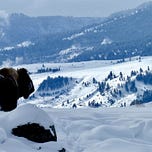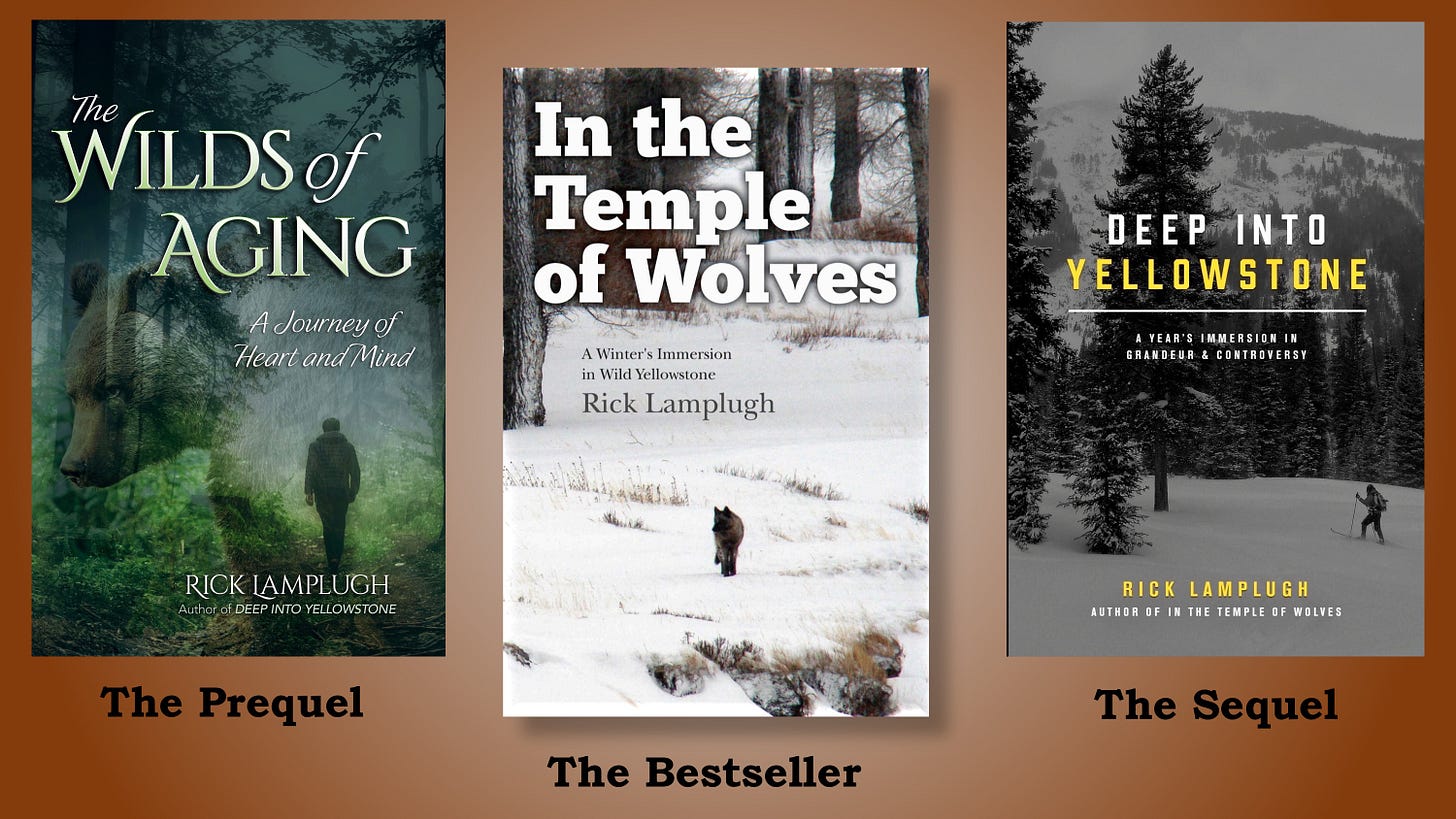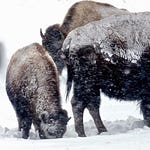One day I was cross-country skiing with friends on a national forest road just outside Yellowstone. As we rounded a bend, I spotted a group of bison. The female pictured above caught my attention. She stood apart from the group, seemingly intent on a spectacular view of Electric Peak. Behind her, the distant terraces at Mammoth Hot Springs steamed away.
To reach here, she and the other bison had migrated at least thirty-five miles from the Lamar Valley. They were led by a matriarch; she probably learned the migration route from matriarchs that once led her. Along the way, this group would have walked in the plowed park road, conserving energy and giving them a better chance to win their annual race between starvation and spring. If they had any thought of the danger of being captured and shipped to slaughter or shot by hunters, their need for less snow and more food overwhelmed it.
Plus, migration comes naturally to bison; that’s how we came to have this magnificent animal in Yellowstone at all.
Two million or so years ago, a much smaller animal in southern Asia began moving north and evolving. No one was around to record that long migration and slow evolution. But I can imagine capturing it with time lapse photography taken over, let’s say, 500,000 years. Playing that video back, we would watch that smaller animal evolve. We’d see the head grow larger, better suited for pushing away snow to uncover life-sustaining grasses. As that head grew heavier, a shoulder hump would appear, evidence of the crane of muscle and bone required to maneuver that massive head. We’d see the fur grow longer for better protection against consistently colder temperatures.
And there’d be adaptations we couldn’t see. Beneath that lengthening fur, the hide would grow thicker, providing more insulation. The animal would become better at producing and storing fat, the secret ingredient for surviving long winters devoid of nutritious grasses.
With the passage of time, an animal similar in appearance to the bison we know eventually appeared. The bison migrated north until reaching the area now called Siberia, where they encountered the Bering Strait, a body of water too wet to graze and way too wide to swim. Stopped in their tracks, bison settled into northern living.
Then, around 200,000 years ago, bison felt the icy touch of what would be the first of many climatic changes. Over tens of thousands of colder years, the ice in the Bering Strait no longer melted once winter ended. Year-round ice lowered the water level. As the water level fell, a land bridge slowly appeared, connecting Siberia with Alaska. That land bridge—freed from icy water and exposed to warm sun—sprouted an inviting pasture. Bison followed their noses and grazed across this 2,500-mile bridge to North America.
Once across, they turned south and migrated through the Yukon to the wild Great Plains where they grazed with mammoths, mastodons, and even camels. Big sabertooth tigers, American lions, and dire wolves hunted those grazers. And eventually so did our early ancestors. Many of those huge animals—both predator and prey—that shared the plains with bison vanished, perhaps because of human hunting, perhaps because of climate change.
But the ancestors of Yellowstone’s bison survived and prospered. By the time European settlers reached the east coast of the New World, at least 30 million bison roamed North America. Then settlers headed west intent on conquering the continent. After fifty years of slaughter for food, sport, ethnic cleansing, or profit, almost all those millions of bison were gone.
Yellowstone contained the only surviving wild herd, and protecting even those few bison was a challenge. By 1900 only around two dozen bison remained in Yellowstone.
A concerned congress appropriated money for rebuilding the herd. In the 1930s that captive herd was set free and started breeding with Yellowstone’s few remaining wild bison. That free-roaming herd began to grow. And grow. And grow.
After one of the first and most successful reintroductions in the world, the park now has two herds totaling around 5,000 head. One roams the Lamar Valley. The other grazes in Hayden Valley.
I’m simply in awe of this incredible survivor that is the result of two million years of evolution and migration. Certainly, bison deserve the title of our national mammal.
But even more, our national mammal deserves the right to roam free—not just in Yellowstone—but outside the park in our nation.
Thanks for joining me in this Love the Wild! If you haven’t yet subscribed, I hope you’ll do so. It’s free and brings a Love the Wild letter to your inbox each week. In addition to podcasts such as this one, you’ll enjoy a variety of stories, photo essays, videos, commentaries, excerpts from my books and more. With each, I hope to warm your heart and excite your mind as we share moments with wildlife and in wild lands.
I write and photograph to protect wildlife and preserve wild lands. My bestselling In the Temple of Wolves; its sequel, Deep into Yellowstone; and its prequel, The Wilds of Aging are available signed. My books are also available on Amazon unsigned or as eBook or audiobook.













Share this post